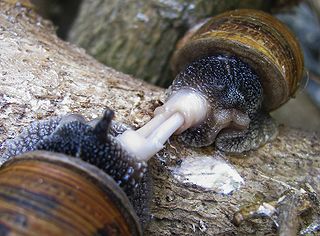
Sex is the biological trait that determines whether a sexually reproducing organism produces male or female gametes. During sexual reproduction, a male and a female gamete fuse to form a zygote, which develops into an offspring that inherits traits from each parent. By convention, organisms that produce smaller, more mobile gametes are called male, while organisms that produce larger, non-mobile gametes are called female. An organism that produces both types of gamete is hermaphrodite.
In biology, gonochorism is a sexual system where there are two sexes and each individual organism is either male or female. The term gonochorism is usually applied in animal species, the vast majority of which are gonochoric.

Pandalus borealis is a species of caridean shrimp found in cold parts of the northern Atlantic and northern Pacific Oceans, although the latter population now often is regarded as a separate species, P. eous. The Food and Agriculture Organization refers to them as the northern prawn. Other common names include pink shrimp, deepwater prawn, deep-sea prawn, Nordic shrimp, great northern prawn, northern shrimp, coldwater prawn and Maine shrimp.

Lysmata amboinensis is an omnivorous shrimp species known by several common names including the Pacific cleaner shrimp. It is considered a cleaner shrimp as eating parasites and dead tissue from fish makes up a large part of its diet. The species is a natural part of the coral reef ecosystem and is widespread across the tropics typically living at depths of 5–40 metres (16–131 ft).
Dioecy is a characteristic of certain species that have distinct unisexual individuals, each producing either male or female gametes, either directly or indirectly. Dioecious reproduction is biparental reproduction. Dioecy has costs, since only the female part of the population directly produces offspring. It is one method for excluding self-fertilization and promoting allogamy (outcrossing), and thus tends to reduce the expression of recessive deleterious mutations present in a population. Plants have several other methods of preventing self-fertilization including, for example, dichogamy, herkogamy, and self-incompatibility.

Sequential hermaphroditism is one of the two types of hermaphroditism, the other type being simultaneous hermaphroditism. It occurs when the organism's sex changes at some point in its life. A sequential hermaphrodite produces eggs and sperm at different stages in life. Sequential hermaphroditism occurs in many fish, gastropods, and plants. Species that can undergo these changes do so as a normal event within their reproductive cycle, usually cued by either social structure or the achievement of a certain age or size. In some species of fish, sequential hermaphroditism is much more common than simultaneous hermaphroditism.

Male is the sex of an organism that produces the gamete known as sperm, which fuses with the larger female gamete, or ovum, in the process of fertilisation. A male organism cannot reproduce sexually without access to at least one ovum from a female, but some organisms can reproduce both sexually and asexually. Most male mammals, including male humans, have a Y chromosome, which codes for the production of larger amounts of testosterone to develop male reproductive organs.

Thor amboinensis, commonly known as the squat anenome shrimp or sexy shrimp, is a species of shrimp found across the Indo-West Pacific and in parts of the Atlantic Ocean. It lives symbiotically on corals, sea anemones and other marine invertebrates in shallow reef communities.
Androdioecy is a reproductive system characterized by the coexistence of males and hermaphrodites. Androdioecy is rare in comparison with the other major reproductive systems: dioecy, gynodioecy and hermaphroditism. In animals, androdioecy has been considered a stepping stone in the transition from dioecy to hermaphroditism, and vice versa.

A hermaphrodite is a sexually reproducing organism that produces both male and female gametes. Animal species in which individuals are either male or female are gonochoric, which is the opposite of hermaphroditic.

An organism's sex is female if it produces the ovum, the type of gamete that fuses with the male gamete during sexual reproduction.

Palaemonetes paludosus, commonly known as ghost shrimp, glass shrimp, and eastern grass shrimp, is a species of freshwater shrimp from the southeastern United States. They can be considered a keystone species based on the services they provide to their habitat. They are also popular in the domestic aquarium business.

Lysmata is a genus of shrimp in the infraorder Caridea, the caridean shrimp. The genus belongs to the family Lysmatidae. Lysmata are popular ornamental shrimp in the marine aquarium trade for their bright color patterns, interesting behaviors, and ability to control certain aquarium pests such as sea anemones of the genus Aiptasia. They are known to command high prices on the pet market.

Neotrypaea californiensis, the Bay ghost shrimp, is a species of ghost shrimp that lives on the Pacific coast of North America. It is a pale animal which grows to a length of 11.5 cm (4.5 in). One claw is bigger than the other, especially in males, and the enlarged claw is thought to have a function in mating. N. californiensis is a deposit feeder that lives in extensive burrow systems, and is responsible for high rates of bioturbation. It adversely affects oyster farms, and its numbers are controlled in some places by the application of pesticides. It carries out an important role in the ecosystem, and is used by fishermen as bait.

Thor is a genus of shrimp in the family Thoridae, containing the following species:

A shrimp (pl.: shrimp or shrimps is a crustacean with an elongated body and a primarily swimming mode of locomotion – typically belonging to the Caridea or Dendrobranchiata of the order Decapoda, although some crustaceans outside of this order are also referred to as "shrimp".
Eulimnadia texana, the Texas clam shrimp or desert shrimp, is a species belonging to the Limnadiidae family.
Trioecy is a sexual system characterized by the coexistence of males, females, and hermaphrodites. It has been found in both plants and animals. Trioecy, androdioecy and gynodioecy may be described as mixed mating systems.

Simultaneous hermaphroditism is one of the two types of hermaphroditism, the other type being sequential hermaphroditism. In this form of hermaphroditism an individual has sex organs of both sexes and can produce both gamete types even in the same breeding season.

A sexual system is a distribution of male and female functions across organisms in a species. The terms reproductive system and mating system have also been used as synonyms.











